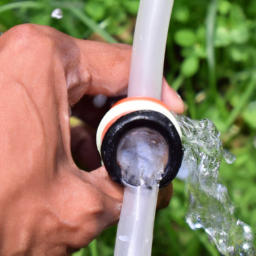How To Increase Water Pressure Garden Hose
How To Increase Water Pressure In Garden Hose
How To Increase Water Pressure In Garden Hose
Introduction
Having a garden hose with low water pressure can be an aggravating problem. Usually, this happens due to a buildup of sediment buildup in the hose or cistern. Thankfully, there are many ways to increase the water pressure inside a garden hose. In this article, we will explore the features, benefits, pros & cons, case studies, FAQ's, mistakes people make, and best practices of increasing water pressure in garden hoses.
Features
There are several features that can help with increasing water pressure within a garden hose. Firstly, having the correct garden hose size for the task can be extremely useful. The ideal size of garden hose should range between three-quarter of an inch to five-eighths of an inch. If the length of the hose is too long, it can reduce water pressure. Another feature that can aid in increasing water pressure is a pressure sprayer that can be attached to the end of the garden hose. This will create a surge of pressure within the hose and can help remove sediment buildup.
Benefits
Increasing water pressure in garden hoses can offer a plethora of benefits. Firstly, increased water pressure can lead to more efficient garden hose usage which can reduce wasting water. Having higher water pressure can also help with intended tasks like cleaning surfaces or spraying fertilizer. Lastly, Shearing the buildup of sediment in the hose can help increase water flow and pressure dramatically.
Pros & Cons
There are several pros and cons that should be considered when trying to increase water pressure in garden hoses. Firstly, the pros include increased efficiency of water usage reducing water waste and better results for intended tasks like cleaning and spraying fertilizer. As for cons, one should consider the cost of purchasing additional equipment like pressure sprayers or additional hoses.
Case Studies
There are several case studies that can help illustrate the process of increasing water pressure in garden hoses. Firstly, an illustrative case study can be found on the website Gardener's Path regarding a homeowner that had low water pressure in their garden hose. To fix the low water pressure, the homeowner replaced their garden hose and installed a pressure sprayer which helped them immensely with their task. Additionally, another case study can be found on the website Popular Mechanics, regarding a homeowner having the same issue. The homeowner in this case opted to replace their old garden hose with a newer one and the issue was solved.
FAQ's
Q: How can I increase water pressure in the garden hose?
A: There are several ways one can increase water pressure in their garden hose. Firstly, one should ensure they are using the correct size of the garden hose. Secondly, one should consider attaching a pressure sprayer at the end of the garden hose for an increase of pressure. Lastly, one should look into replacing the garden hose entirely in case of sediment buildup.
Q: How do I know if my garden hose is too long?
A: To know if your garden hose is too long, you should investigate the length of the hose in comparison to the intended task that you would use it for. If the hose is much longer than necessary, it can cause a decrease of water pressure.
Mistakes People Make
When it comes to increasing water pressure in a garden hose, many people make the same few mistakes. Firstly, many tend to use poor quality garden hoses that can easily break or may not be fit for the intended task. Additionally, many people use garden hoses of the wrong size which can also lead to low water pressure. Lastly, many people simply opt to purchase more equipment when all they need to do is replace their garden hose.
Best Practices
When it comes to increasing water pressure in a garden hose, there are certain best practices that should be followed. To begin, one should always start by examining the type and size of the hose. If the hose is not the correct size, it is best to purchase one that is. Additionally, one should consider purchasing a pressure sprayer that can be attached at the end of the garden hose and help provide a surge of pressure when the water is turned on. Finally, it is important to note that periodic replacement of the garden hose can help save time and money in the long run.
Summary
Having a garden hose with low water pressure can be an incredibly annoying problem. Thankfully, there are solutions to this issue. Features that can help include having the correct size of garden hose or attaching a pressure sprayer that can help increase water pressure within the hose. Benefits include increased efficiency of water usage as well as better results for intended tasks. As for considerations to be aware of, one should consider the cost of purchasing additional equipment if needed. Additionally, mistakes people make include using poor quality hoses or incorrect sizes of hoses as well as opting to buy additional equipment when a replacement of the hose is all that is necessary. Finally, best practices to consider include starting with examining the hose size, purchasing a pressure sprayer if needed, and periodic replacement of the garden hose.
Conclusion
To conclude, increasing water pressure in garden hoses can offer several benefits including better efficiency of water usage as well as better results for intended tasks. There are several features that can be employed to help with increasing water pressure. These include having the correct size of garden hoses or attaching pressure sprayers. Additionally, knowledge regarding common mistakes people make as well as best practices to keep in mind can help when troubleshooting low water pressure in garden hoses.

Previous Page
Next Page
